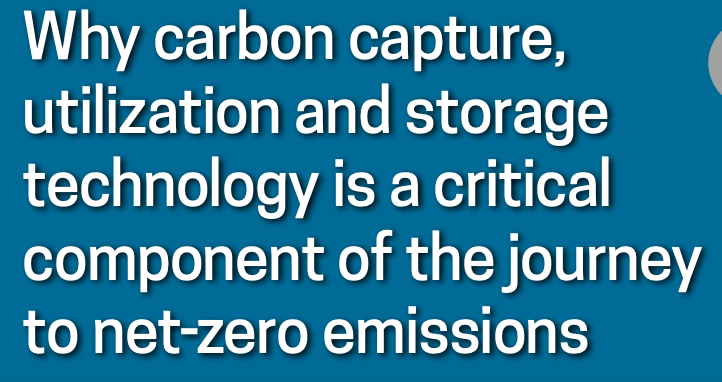By Dr. Neeraj Gupta, Technical Director of Carbon Management for Battelle. “Why carbon capture, utilization and storage technology is a critical component of the journey to net-zero emissions“.
The path to carbon neutrality is not a singular one. It comprises a multitude of routes — because it’s simply not viable to develop climate resilience with one solution. There are several strategies for getting to net-zero emissions and Carbon Capture, Utilization and Storage (CCUS) technology will be one of the most vital.
In fact, Dr. Fatih Birol, executive director of the International Energy Agency (IEA) said “reaching net-zero emissions will be virtually impossible without CCUS.”
Recommended for you: Technology, paving the way for clean energy
Increasing faith in CCUS is based on the considerable progress made in the U.S. Over the last two decades under U.S. Department of Energy (DOE) funded programs and similar global efforts. In addition, clarity on the use of
incentives, like 45Q tax credits, is creating a growing movement toward commercial deployment of proven CCUS capabilities that are safe, effective and efficient. It’s now imperative that we ramp up the development and scaling of this cuttingedge technology as part of the overall strategy to reach net-zero.
Carbon Capture is a Key Component of a Sustainable Energy Portfolio
As the world works to shift to clean energy, we must be realistic about what’s possible. Fertilizer, oil and gas production and operating power plants, refineries, and steel mills emit large quantities of carbon. These processes are also an important foundation for industry, jobs and equitable access to energy. All must be adapted to run on cleaner energy, but doing so will be challenging, costly and lengthy — which is where CCUS can help.
At first, CCUS technology can help bridge the gap during energy transition. Second, it reduce the emissions from these processes while energy storage and renewables ramp up to meet demand. And third, it can also be a component of an equitable and sustainable global energy portfolio. CCUS captures and safely stores carbon emissions in underground reservoirs or uses them for other purposes to produce oil with lower carbon impact.
Natural gas producers can implement CCUS to capture emissions while increasing their use of clean hydrogen and enhanced oil recovery (EOR), and other utilization technologies can reduce overall emissions in the oil and gas industry as the larger energy transition takes place.
CCUS has an increasing role in hydrogen energy, biomass use with CCS. And also carbon dioxide removal with direct air capture or nature-based solutions. A common requirement for all CCUS pathways is the availability of secure CO2 storage reservoirs for large-scale storage over multiple decades of operations and retention over geologic time scales. This is where the geological sciences and oil and gas industry practices play a critical role.
Meaningful Advancement of Carbon Capture Technology is Well Underway
In June, Battelle and its partners successfully concluded CCUS research for the Midwest Regional Carbon Sequestration Partnership (MRCSP). More than two million tons of CO2 was effectively and safely captured and sequestered in three phases between 2008 and 2019, and many of the vital lessons learned from this 20-year project are now being applied to a number of commercial projects.
Battelle, the Illinois State Geological Survey and other team members are building upon the knowledge gained. In order to head-up the Midwest Regional Carbon Initiative (MRCI). It is a DOE-funded project to further advance CCUS research by addressing key technical challenges. In addition, obtaining and sharing data to support CCUS, facilitating regional infrastructure planning, and performing regional technology transfer. Similar regional partnerships and succeeding regional initiatives funded by the DOE across the U.S. are paving the way for commercial deployment.
The MRCI program spans 20 states from the Midwest to the East Coast. And it covers more than one-third of the nation’s CO2 point sources. The MRCI is working to scale up CCUS acceptance and deployment. Its efforts will ultimately serve as a blueprint for the critical expansion of commercial projects, both stateside and abroad. These efforts are crucial as the UN IPCC report estimates we must remove anywhere from 100 billion to a trillion tons of carbon already in our atmosphere by the end of the century, depending on how much more we keep on putting into it.
To do this, we must advance more DOE-funded programs geared toward deploying CCUS throughout the country. And also enhance policies to enable national CCUS deployment. According to a September 2021 IEA report, up to $160 billion needs to be invested in CCUS technology by 2030, a ten-fold increase from the previous decade.
In Conclussion
There are many paths to net-zero emissions, and CCUS must be deployed alongside other technologies. Such as energy-demand management, decarbonization of electricity, electrification of energy end use. But also, reductions in agricultural emissions, and carbon dioxide removal (CDR) measures, to ward off worsening climate impacts. We must advance CCUS now. Because it has a direct impact on emissions reductions in key sectors where they’ve been historically hard to abate. Achieving carbon neutrality is essential as we work to foster climate resiliency not only in the U.S., but across the globe.


